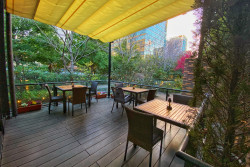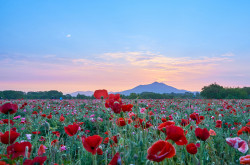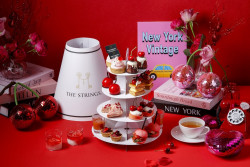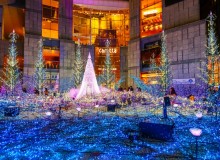
February 1, 2013
Grow Ops
Find the story behind your produce at Tokyo’s farmers’ markets
By Metropolis
Originally published on metropolis.co.jp on February 2013


Farmers’ markets are nothing new to Japan. Asaichi (morning markets) traditionally took place at prominent public places where regional farmers would display their wares for perusal by city residents. Some, like Akita’s Gojome market, still run five hundred years later as popular tourist attractions and sources of locally grown food. Others disappeared as modern supermarkets impacted farmer numbers, or because of changes in landowner priorities.
In 2009 the Japanese government, facing a dual conundrum of declining food production and a citizenry wary from a series of food scares, created Marché Japon. New markets and some established ones joined this effort to boost the ailing agricultural sector and soothe public fears. A public-relations campaign involving celebrities, YouTube, and various events started reconnecting eaters with growers.
Today, a handful of Western-style markets in Tokyo bring farmers, producers, craftsmen, and customers together to talk, trade, and build community in an age-old tradition. Successful markets have solid customer and vendor bases, reliable schedules, and fun atmospheres. Customers know where to find a favorite grower and the grower knows the effort of coming into the city will be rewarded.
“It’s very different from the supermarket,” says Yusuke Tanaka, manager of both the United Nations University and the Gyre Farmers’ Markets. “People come because they like the vegetables, but they also really like talking with farmers. At the supermarkets there is no talk.” Visitors find, he says, what they like to call “my favorite farmer.”
Since setting up their first tents in 2009, the number of vendors and visitors at the UNU market has more than doubled. The 60 regular vendors meet upwards of 10,000 visitors a day, claims Tanaka.

“At first, people only walked by and looked,” says Tanaka. “When they saw us here every Saturday and Sunday, they stopped. They met the farmers. They became regulars.”
Takayuki Shimizu, manager of the Ebisu Farmers’ Market, agrees. “These kinds of places are ‘B2C’—business to customer—rather than B2B,” he said during a recent visit to the bi-monthly market. Customers meet the grower, the pickler, and the jammer. Producers, in turn, put a face alongside their products, answer questions and develop relationships.
Goda Masaki, an Akita rice farmer, finds the Ebisu Farmers’ Market a perfect testing ground for his carrot, sun-dried tomato, and basil yasai mochi (vegetable rice cake). On this Sunday he hands out samples with a small crew he met through NOPPO, a company that partners university students interested in agriculture with farmers seeking new ideas. “It’s a great way to support independent farmers,” says NOPPO CEO Yukiko Fukumoto, also helping at the table that day.
Shigeto Katayama, manager of the Roppongi Ark Hills Farmers’ Market, recalls when his market was started ten years ago by a group of Ibaraki growers who came in every Saturday with their wares. Four years ago, the Mori Corporation offered them the use of Karajan Plaza at the center of a newly completed residential complex. Now in that plaza, upwards of 40 vendors meet 1,500 loyal customers every week.
“Our purpose is to make community. Farmers and customers talking and laughing together is the most important,” comments Katayama. “We think a good farmers’ market is part of a good lifestyle.”
Yoshio Kosaka’s stall at the Roppongi market is piled with bundles of carrots, haksai (Chinese cabbage), negi (long onions), daikon, and an assortment of winter greens from his farm in Kokubunji. He nods and smiles as a woman points to a basket of pale udo (spikenard). “I bought that last week. It was really delicious,” she says. Kosaka grins wider as he thanks her. They talk about how it grows (under cover to keep it white) and its season (January through April). She asks a few more questions before buying more udo along with other vegetables. As she arranges her bag, she waves farewell before heading to a nearby fish vendor.

Kazuo Keino, owner of the high-rise and plaza where the monthly Nippori Farmers’ Market takes place, had something similar in mind. Steps from Nippori Station and the historic Yanaka district, a market seemed a good way to integrate new residents. Atsuko Fujita, Nippori’s manager, recalled the first market two years ago—made up of just herself and four farmers. Nippori now hosts more than thirty vendors a month along with workshops, prepared foods, and music.
The Earth Day Market started in 2006 in order to support organic growers. According to Hiroshi Tomiyama, manager and founder, most farmers there have been in business less than ten years. Nearly all are small family operations with many in their first year, while other vendors are transitioning from other work to farming.
“The first years of farming can be very unstable. By coming here, farmers establish a customer base that will help them become successful,” explains Tomiyama.
Hiroto Matsufuji, a Yamagata fruit grower, comes to the Earth Day Market each month. Originally from Chiba, Matsufuji left the airline industry ten years ago to focus on his orchard. He sees the market as a place to share his joy in farming and make a living. “Farming is art. It’s my life. If I don’t sell, then I’m done. The market communicates all of that,” he says.
Shoppers find it worthwhile, too. Prices, especially for organic items, are the same as or less than in the supermarket. Farmers’ markets also offer an unmatched diversity of fruits and vegetables—more than 180 can be found at one Earth Day Market, according to Tomiyama—as well as a unique selection of other food items and crafts.
The markets also mean less packaging, more seasonal eating, and new recipes to help with that. There is your train fare, and lugging home two kilograms of rice in a backpack full of produce can be a weighty affair. But meeting the grower, having fun, and knowing the where and how behind the food on your table is a tough deal to beat.
Earth Day
Tokyo’s only all-organic, all fair-trade market features a fantastic variety of vendors offering all one might need for dinner, breakfast, and beyond. Some of Shizuoka’s best organic tea, a fine selection of rice growers, purveyors of old-fashioned grains, homemade miso, and an ume jam that will knock the socks off your taste buds are just a few of the treasures to be discovered here. Throw in a little music, workshops, and artisans and you’ll find yourself becoming a regular.
Last Sunday of every month, 10am-4pm, Yoyogi Park Elms. Nearest stn: Harajuku.
Ebisu
A charming market at the entrance of Ebisu Garden Place, visitors will find a lovely selection of growers and producers from all over Japan showcasing everything from the usual seasonal fruits and vegetables to the more exotic dried natto (a delicious, crunchy version of the usual “aromatic” bean). Handmade soaps and other craft items also join an array of juices, jams, and teas. Each month also features a different region of Japan and its culinary delights.
First and third Sunday of each month, 11am-5pm. Nearest stn: Ebisu.
Gyre
One flight of stairs below Omotesando’s fashionable hub-bub, the Gyre Farmers’ Market is where fashionistas do their grocery shopping. Gyre offers visitors a more intimate and indoor version of the UNU Farmers’ Market. Seasonal produce, including a nice selection of heirloom and foreign varieties of vegetables, is showcased at its best along with a variety of pickles, jams, and baked goods. Never overly crowded, there’s plenty of opportunity to talk with the farmers or sample a tasty new spread.
Second and fourth weekend of every month, 11am-5pm. Nearest stn: Harajuku or Meiji Jingumae.
Nippori
Just outside Nippori Station and on on the edge of Yanaka, one of Tokyo’s most outstanding historic districts, the Nippori Market features a carefully selected combination of seasonal produce, music, crafts, and prepared foods. Tohoku farmers display their best vegetables, and a monthly regional theme draws growers and producers from around the country. A nice selection of food carts, too, offer some of the best manju and tea around, as well as other tasty fare.
Third weekend of every month, Saturday and Sunday, 10am to 5pm. Nearest stn: Nippori.
Roppongi Ark Hills
A bustling market nestled in the central courtyard of Roppongi’s Ark Hills where shoppers will find everything from household items, preserves, handmade crafts, fresh produce from Tokyo farmers in Kokubunji and Okutama, along with a wide variety of fruits and vegetables. Small- to medium-sized growers and producers will help visitors discover a new variety of citrus or a novel way to love old friends like daikon and spinach. Regular workshops and seasonal food themes make for a fun atmosphere, too.
Every Saturday, 10am-2pm. Nearest stn: Tameikesanno.
UNU
Sixty growers and producers from all over Japan are on hand every Saturday and Sunday with the best seasonal fare their fields and kitchens have to offer. Find everything from jams to pickles to fresh produce to baked goods and tea along with a wide selection of unique handmade crafts. Some vendors don’t come every weekend, so ask about a schedule if you find someone you like. A night market every third Saturday offers music and themed food sampling, too.
Every Saturday and Sunday, 10am-4pm. Nearest stn: Omotesando or Shibuya.







